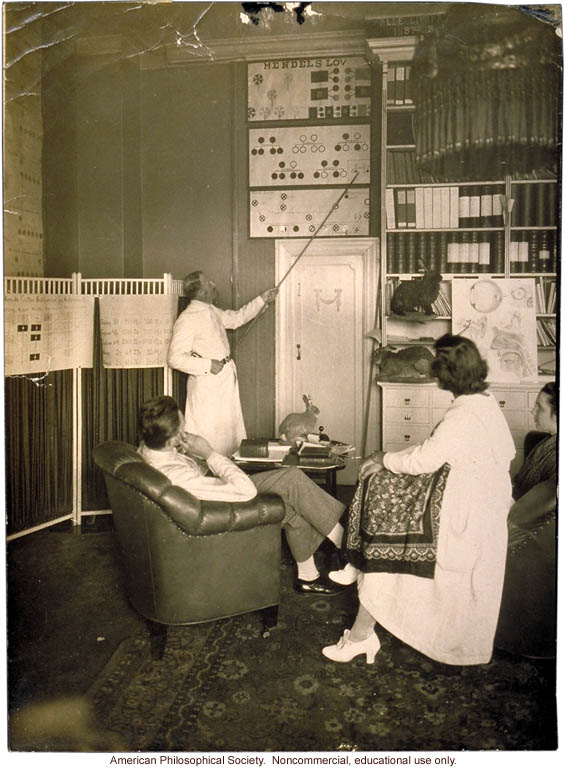Race-crossing and glands: Some human hybrids and their parent stocksPosted in Anthropology, Articles, Health/Medicine/Genetics, Media Archive on 2010-12-08 16:49Z by Steven |
Race-crossing and glands: Some human hybrids and their parent stocks
Eugenics Review
Volume 23, Number 1 (April 1931)
pages 31-40
Jon Alfred Mjöen, Director
Vindern Biological Laboratory (Oslo, Norway)
(Paper read at the ninth meeting, 1930, at he the International Federation of Eugenic Organizations.)
The earlier displacements of population, the migrations of which history relates, usually took place during long epochs of time. Amongst the greatest were the migrations of the Arabs, the Semites, and the Mongols. These wholesale movements of population were of quite a different character from the Viking raids from the Mediterranean lands and Northern France, the Gothic invasion of Italy and Spain, the Norman’s conquering expeditions to England, the expulsion of the Huguenots, or the emigration of Puritans to the United States, and the Walloons to Sweden.
But even the most stupendous invasions that history records, hardly assumed such dimensions as the movements of population we have witnessed in our own days. The system of control that is called inspection of passports shows, for example, that the racial elements of alien origin which in a three-year period after the War have crossed into Central Europe from East, number no less that 600,000. The emigrants from the East settled in Berlin, Paris, and other large cities (according as the rate of exchange varied), and to-day they form a constantly increasing contingent of Asiatics, Russians, Poles, Galicians, Greeks, and various others. New York alone was invaded, in the course of a three-year period, by a similar contingent of foreign racial elements amounting to about on and half million.
Nobody who with open eyes has observed the masses in the great modern cities, Paris, Berlin, New York, Chicago, will have failed to be struck by the manner in which the racial physiognomy of the population is in process of changing. Clean, open racial features are becoming more and more rare in these masses in the slums, which in the real sense of the word are amorphous. All unity of form is dissolved, and a hideous confusion of all possible coulours and shapes from all the races of the earth has taken place.
The picture which we see before our eyes everyday, so to speak, on journeys in Europe, North Africa, and America, raises a question of importance: What will be the effect, the final result of this gigantic blood-mixing? The picture gives an impression of lack of guiding-instinct, lack of stability and balance. But is this lack of balance a result of social or biological causes; and have we any reason to believe that crossing with foreign races will have a deleterious effect upon the native stock?…

|
Jon Alfred Mjøen, director of the Vindern Biological Laboratory (Oslo, Norway) explaining pedigree to children Heljar, Sonja, and Fridtjof. Circa 1920. American Philosophical Society, , 2000.1282©1999-2004: Cold Spring Harbor Laboratory; American Philosophical Society; Truman State University; Rockefeller Archive Center/Rockefeller University; University of Albany, State University of New York; National Park Service, Statue of Liberty National Monument; University College, London; International Center of Photography; Archiv zur Geschichte der Max-Planck-Gesellschaft, Berlin-Dahlem; and Special Collections, University of Tennessee, Knoxville.
|
…Hybrids’ Tempermental Instability
In full agreement with this suggestion of glandular disturbance is the general opinion of biologists that the human hybrid shows a typical instability in mental and moral respects—a want of balance. His motives and actions are incalculable, his impulses stronger that his self-control. I feel more and more convinced that the inmates of our prisons and asylums are to a large extent recruited from these types of mixed race, who numbers are constantly rising on account of increasing intercourse between populations from all parts of the world.
A special group of individuals which is causing a great deal of trouble in our northern countries, Norway and Sweden, is the Gipsy (tater) group. We know very litte about their origin, except that they are badly race-mixed and have all the characteristics of unbalanced hybrids. They are vagabonds, beggars, loafers, and criminals. Whole families of this hybrid population are filling up our prisons and asylums.
One hears, of course, of prominent hybrids—Booker Washington, the American teacher and reformer, was a Mulatto, and Porfirio Díaz, President of Mexico, was a Mestizo. But they are exceptions to the rule, and they are few compared with the enormous number of human hybrids all over the world. We find it very often stated that the famous Swedish writer August Strindberg, was of very “mixed ascendency.” I do not know how far this is assertion is to be relied upon. But what would be likely to be the result if we advocated race-crossing on such premisses? If by deliberate experimental breeding of men we could produce 10,000 ‘Stindberg blends,’ we should obtain no small contigent with Strindberg’s brutality, his melancholy, his capriciousness, his violent temper, his pessimism, his cynicism towards women (though he married four times), and all his lack of self-control—and yet we might be cheated of the expected types with Strindberg’s creative genius…
Read the entire article here.
